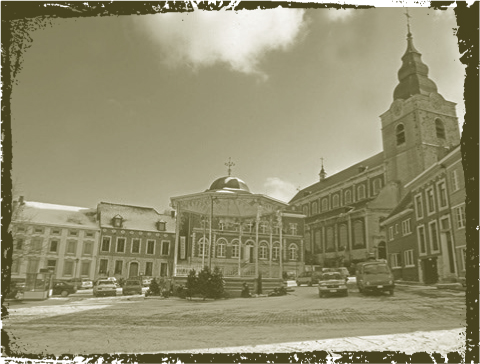
Hoegaarden is well known as the birthplace of wheat beer.
There are few stories in the long history of beer as surprising as the revival of Belgian white (wit or witte in Flemish, bière blanche in French), a style that was all but left for dead sixty years ago. This acidic, milkywhite beer was brewed for centuries in the towns between Brussels and Hoegaarden (pronounced Hoo-gar-den), but world wars, lagers, and industrialization took their toll, and the last of the witbier breweries, Tomsin, shut down in 1957. Eight years later, a milkman decided to revive the style. He drew on his experience of having worked at Tomsin years before and consulted with a retired brewer to create a new recipe. In 1966, he started selling a revival witbier.
It substituted spices for the lactic acidity of the old witbiers, and was a crisp, refreshing ale that would gradually win hearts far beyond the town lines of Hoegaarden. Remarkably, the obscure beer would one day be picked up by brewing giants in the United States and become the best selling ale style. Now most beer-producing countries from France to Ukraine, Argentina to Japan have their own local examples. ■
IN THE ROUGHLY rectangular area running from the valleys south of Brussels north to Mechelen, as far east as Maastricht and Liège, is a famous stretch of towns that have produced some of the most renowned wheat beers in the world. We now associate witbier with the village of Hoegaarden, whose fame actually stretches back centuries. In the early sixteenth century, tiny Hoegaarden fell between the regions ruled by Liège and Brabant, placing it in a tax-free seam that gave it an exporting advantage lasting through the end of the eighteenth century. During that period, beer exports buoyed an energetic collection of hometown breweries—as many as thirty-eight in the mid-1700s.
But Hoegaarden wasn’t the only famous town brewing wheaty beers in the region. The town of Diest produced a creamy, golden wheat beer that was “highly sought after by afficianados,” according to the nineteenth-century brewing scientist Georges Lacambre. To Brussels’s north, the town of Mechelen was famous for a brown beer that might be a second cousin to the tart brown ales made in Flanders. Closer to Hoegaarden, Leuven was a famous brewing center and produced a “refreshing, frothy” bière blanche and a darker wheat beer called Peeterman. And in Brussels and the river valleys of Pajottenland, the wheat ale of choice was lambic.
“When fresh, this beer is very pale, very refreshing, and strongly sparkling. Its raw taste has something wild that is similar to the Leuven beer it resembles in many respects—but it is not as sweet as the latter, no doubt because it contains more oats and less wheat, and because the boil of the sweet beer is shorter than the equivalent wort used to prepare Leuven white beer.”
—GEORGES LACAMBRE, 1851
Lambics and the beers produced in Leuven and Hoegaarden had much in common. They were made with grists of unmalted wheat (20 to 60 percent) and often oats. Those known as blanche employed “wind-malted” barley—that is, unkilned grain, left simply to dry in the breeze. The Leuven and Hoegaarden beers were cloudy and very pale.
All Belgian breweries used flat cooling vessels known as “cool ships” before the twentieth century, so tart acidity from wild yeast and bacteria was a given. How the breweries encouraged or discouraged this characteristic depended on the way they brewed the beer. Lambic brewers never added yeast, letting the beers ferment spontaneously—or from wild yeasts only. In some of the methods of Leuven, brewers boiled their worts; in others, they set aside a portion of several unboiled mashes, where a coating of wild organisms on the yeast would continue to thrive. Hoegaarden’s brewers used a mixture of these techniques. Lacambre reported that brewers in Hoegaarden spontaneously fermented their beer after blending mixtures of three strengths of wort, one unboiled. (A similar method that allowed the beer to retain its spontaneous fermentation was used until the 1930s.)
Collectively, these beers formed an extended family, but what made them distinctive was the length of time they were allowed to age. Brewers put lambics away for months or years, allowing all of the wild yeasts to exert their influence. The beers of Leuven and Hoegaarden were served fresh. In the case of Leuven’s beers, aging took just four or five days, and never longer than two weeks in the summer. In Hoegaarden, because of somewhat slower-acting wild yeasts, aging took eight to fifteen days, and continued to ferment in the serving casks. Hoegaarden’s beer was effectively a variation on a green lambic; because many of its microorganisms didn’t have a chance to get active, the beer was characterized mainly by lactic tartness.

Hoegaarden is well known as the birthplace of wheat beer.
Following the Second World War, Belgium suffered an enormous loss of indigenous beer types. Once renowned, ancient styles like Peeterman, uytzet, and Antwerp’s indigenous barley beer were all dying as people turned to industrial lagers. Up to a dozen major styles would be lost by the 1960s; among the old ales from the wheat belt, lambics were the survivors.
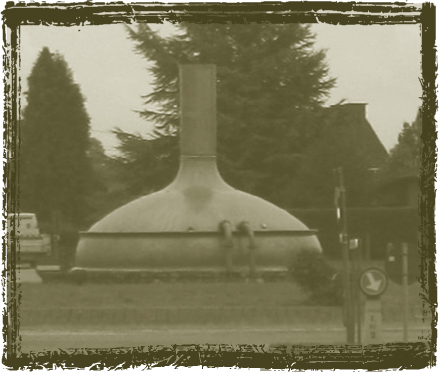
An old copper kettle greets visitors as they enter the city.
On one hand, the 1960s were a terrible time to try to resuscitate a lost style; consumers were moving away from tradition and looking for more consistent, modern beer that would last longer than a few days. On the other hand, there might have been some genius in the timing. One virtue of extinction is nostalgia, and the lost white beers of Hoegaarden were still very much in the memory of people like Pierre Celis, the milkman who had earlier worked in the last brewery in town.
Hoegaarden. When he founded his witbier brewery in the mid-1960s, Pierre Celis named it after the town of Hoegaarden. Later, in the late 1970s, he changed it to the monastic-sounding De Kluis in a well-played attempt to boost sales. After a fire gutted the brewery in 1985, Celis sold a majority share to the local giant, Stella Artois, and moved to Texas to start over. In the three decades since it acquired the brand, Artois and its various parent companies (currently Anheuser-Busch InBev) have called the beer Hoegaarden.
What was once a small Belgian brewery has become a giant, but its iconic beer is still brewed in the village from which it takes its name. InBev takes pains to associate Hoegaarden with the town’s rich heritage—the label touts the date it was founded—but the beer has gotten less interesting over the years. In the early 1990s, Michael Jackson wrote that “its fruity sourness gives way to a honeyish sweetness.” Whatever you can say about its honeyishness, there’s certainly nothing sour left for drinkers in the new millennium. The exigencies of being an international brand have nudged it in a blander direction. Yet Celis’s legacy is clear: After only an eight-year gap between batches of witbier, the town of Hoegaarden is once again synonymous with its local beer.
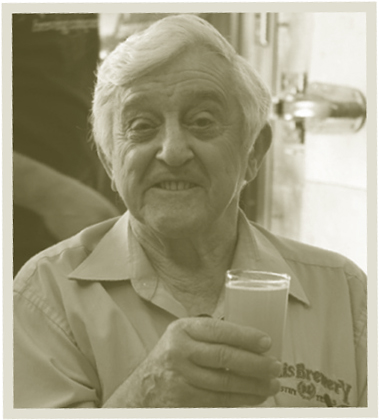
Instead of picking up where the old breweries left off, Celis had a different idea. He reformulated the recipe and adopted modern brewing methods. The grist for his Oud Hoegaards Bier followed tradition, with pale barley, unmalted wheat, and oats. But instead of wild fermentation, Celis pitched a characterful strain of yeast. To evoke the crispness and tang of lactic acid, he used the peels from bitter oranges and coriander. Much as is common in Belgium today, Celis also bottle-conditioned the beer for a month before releasing it.
That beer sparked a (slow) revolution. Celis labored for years, selling around 1,300 barrels annually until he changed the name of his brewery to De Kluis (“the cloister”) in 1978. Associating one’s beer with the monastics was a tried-and-true gambit in Belgium, and it worked for Celis. His beer took off, and soon the style had spread to the Netherlands. By 1985, Celis’s business had grown nearly fifty-fold. He sold a portion of the company to Stella Artois, precipitating the chain of events that eventually led to the formation of InBev. In another radical move, Celis decided to sell the company and relocate in Texas in 1992, bringing witbier to North America.
The style had surprising legs. Witbiers would eventually pop up in unlikely places like Japan and Eastern Europe. In France and North America, witbier became a staple for craft breweries. Although Celis found success in the United States, it was actually Coors that made the style a huge American success with its Blue Moon label. For years this appeared to be only an interesting experiment, but by the mid-2000s, it was clearly bound for success. Anheuser-Busch responded with Shock Top Belgian White and now the two beers account for millions of barrels of production, making witbier America’s bestselling ale. ■
“For every brew of 2,500 liters (one thousand bottles) use 625 kilos raw material such as unroasted malt, oat, and wheat. Oat and wheat are then ground and undergo three processes with boiling spring waters, successively at [113°F, 131°F, and 163°F]. The mixture remains two hours in a boiler. Then seven kilos Czech hop is added. This wort chills to [63°F] and ferments in the yeast tub for seven days. Then follows a secondary fermentation for about a month in beer tanks. This beer is not filtered.”
—PIERRE CELIS: MY LIFE, BY RAYMOND BILLEN
A MUG OF WIT is a curious thing. It looks like a pilsner blended with coconut milk, and vents a tropical aroma. Yet swish it around and you will detect a soft breadiness and a refreshingly crisp finish—all infused by a citric acidity. White ale is the vanishingly rare style that is at once familiar and approachable while still seeming exotic.
For thirty years, whites were made using a recipe as specific as a Martini’s: unmalted wheat and oats in the grist and coriander and bitter curaçao orange peel. This was Pierre Celis’s prescription, and to international brewers dabbling in Belgian brewing, it might as well have been written on a stone tablet. Wheat and coriander remain the gin and vermouth in the cocktail: inviolable. Thanks to the style’s slow, slight evolution, though, brewers have begun to fiddle cautiously at the margins—using, say, ginger along with coriander. Some have experimented with chamomile, lemongrass, black pepper—anything that puts a twist on the balance between gentle, summery comfort and snappy, crisp refreshment. People know too much about whites for complete reinvention, but brewers can alter the arrangement so long as drinkers still hear the melody.
An oddball recipe is not all that makes white beer unusual: By far the majority of the best examples are now brewed outside Belgium. Indeed, in Belgium, the witbeer style isn’t particularly widespread. Two of the finest versions come from opposite sides of the planet, Maine’s Allagash and Japan’s Hitachino Nest White, and they do a nice job of illustrating the style’s range.
When Rob Tod founded Allagash in 1995, he wanted to highlight Belgian beer styles, and the first product out of the kettle was White—still the brewery’s flagship two decades on. It was inspired by Celis white, one of Tod’s early craft beer encounters. At first, he says, “I thought there was something wrong with it.” That changed as witbier became one of his favorite styles. Tod doesn’t think of white beer as a summer confection, though, and he strives for a refinement eschewed by most other wit makers. Using unmalted wheat, he brews one of the palest whites; it looks a bit like unfiltered pear juice. Tod’s use of a highly attenuative yeast strain is the hallmark of the beer, which ends on a crisp, very dry note. Coriander and orange accentuate the effect, and White evokes the character of the best dry rieslings.
Another Low-Tax White Beer. There’s a strange echo of the law that helped popularize wheat beer in Belgium—a very similar law, centuries later, in Japan. When Kiuchi decided to brew beer in the mid-1990s, they didn’t choose witbier at random. The Japanese brewing laws had just changed, allowing small producers to enter the market. One of the new rules discounted the tax on beer made with 50 percent adjuncts. Hitachino Nest White Ale, made with a grist of flaked (unmalted) barley and wheat and the addition of orange juice, met the criterion.
Unlike relative newbie Allagash, the Kiuchi sake brewery dates back to 1823. But it only started making beer in 1996. It has an eclectic mix of brands and has begun introducing Japanese specialties such as an ale made with rice—similar to sake—and another brewed entirely from Japanese malt and hops. Their witbier, Hitachino Nest White Ale, heads in a different direction from Allagash’s. In addition to unmalted wheat, Kiuchi also uses unmalted barley, which gives the beer a thicker, almost buckwheat-like body. White Ale is spiced not only with coriander and orange peel, but also nutmeg and orange juice. Like Allagash, the elements are light and complimentary, but where Allagash is refined, Hitachino Nest is more rustic.
Within Belgium, the two current pace setters include Caracole, which makes a spirited little darling called Troublette that relies, as does Allagash’s, on a dry, vinous acidity. The other example, and one often cited as the best brewed, is another of Pierre Celis’s many progeny: St. Bernardus Wit. Celis didn’t craft the recipe, but the brewery did call on him to tune it up. St. Bernardus Wit has a massive dose of coriander that infuses the nose and palate, but is balanced by a tangy, tart finish. ■
WHEN HE ADAPTED the recipe for the first modern white, Pierre Celis produced a bottle-conditioned beer that looked in many respects like other Belgian ales. With spices and a grist of oats and unmalted wheat it was slightly unusual—but these were all familiar ingredients in the Belgian canon. Celis fermented his wit cooler than most modern versions, but this was only a modest deviation. As a result, the style has changed little in the fifty years since Celis first introduced his new recipe.
The grists of old Hoegaarden beers routinely employed unmalted wheat—originally as a way to minimize taxes and later by tradition. Oats were also commonly used, not just in bières blanches, but throughout Belgian brewing. Celis returned to these grains for his recipe, but not all brewers do. Some use malted wheat (Blue Moon); some don’t use oats (Allagash). Brewers use the grist to emphasize different aspects of their beers. Since the style is so lean and delicate, the grist plays a substantial role in the overall character, so these decisions lead to noticeably different interpretations. Some incline toward a fuller, breadier quality, others toward light crispness.
The real distinctiveness of witbier comes from its citric spiciness—which may come from actual spices or from the action of the yeast. The role of yeast should not be overlooked. Although Celis originally fermented his white cool, it is more common to follow the Belgian practice and let the temperature nose up into the mid- or upper seventies where the beer will form fruit and spice notes—as wits from Hoegaarden, New Belgium, and Ommegang do. The spices then accentuate this yeast character. Phil Leinhart, at Brewery Ommegang, says, “It’s supposed to be a delicate, refreshing beer and the approach should be a very light touch. It should create a very well-blended beer, and you should think, ‘What is that?’”
Curaçao Orange. The peel of any orange—or any citrus fruit, for that matter—may be used to spice a white beer, but the variety you’ll see most often is curaçao. The fruit is more accurately called a Lahara, the descendant of oranges that Spaniards planted on the Caribbean island of Curaçao in the sixteenth century. The island’s nutrient-poor volcanic soil and dry climate forced the trees to adapt, and the fruit changed in the process. It shrank and became bitter and inedible, but distillers realized the aromatic peel could be used to make curaçao liquor.
And, of course, beer.
Coriander is the style’s workhorse. It’s a versatile spice that can lend sweetness, a lemony snap, or a gentle floral note. Celis used bitter orange peel in his recipe, but brewers sometimes use the peels of sweet oranges, or orange zest—or different citrus altogether. The use of some citrus peel is still a standard practice, though this is a more negotiable element than coriander. More negotiable still are other spices, and many find their way into white ales—though not always explicitly. Even Celis was cagey when asked whether he used additional undisclosed spice. In witbier, it is a brewer’s prerogative to add a dash of mystery. ■
NOTHING STOPS innovation as fast as commercial success, so it’s not suprising that white ales continue to be made using only slight variations on the wheat-and-oats, coriander-and-orange-peel template. Yet their success also makes them attractive to brewers hoping to exploit their popularity. One of the more interesting developments is “white IPA,” a style that combines the soft spice of wits with the natural citrus of American hops. The debut was a collaboration between Boulevard and Deschutes, but Saranac, Blue Point, and others have followed. Some hybrids sound better on paper than when they appear in a pint glass, but white IPAs show real promise. Breweries deemphasize hop bitterness in favor of flavor, and the citrusy continuum—from coriander to Cascade—harmonizes beautifully.
The second variation is a return to the traditional, wild ales of Hoegaarden. The pioneer was Jolly Pumpkin, the Michigan brewery that introduced Calabaza Blanca when it opened in 2004. The beer is a light, 4.8% ABV interpretation, brewed with the standard coriander and orange peel but barrel-aged with wild yeast. Boulevard has done a different version, a strong wit called Two Jokers, additionally spiced with cardamom, lavender, and grains of paradise. These are hybrid wits, combining the wild yeast of previous decades with the novel spices Celis introduced (none was mentioned in old texts). As soured ales become more popular, we may see more examples of old-style bière blanche. Who knows, one day a brewery may even forgo the spice in favor of spontaneous fermentation. ■
Blue Moon Belgian White. In 1995, Keith Villa kicked off a unit within Coors Brewing Company (now MillerCoors) to make ales that would compete in the craft beer market. Ultimately called Blue Moon, it was housed in the Sandlot Brewery at Coors Field and immediately earned plaudits from craft beer fans. One of the initial products was a witbier called Bellyslide Belgian White, a beer made with malted wheat, coriander, the peels from sweet Valencia oranges, and an English ale yeast.
At a time when breweries were trying to figure out how to appeal to mass-market lager fans, Villa signaled his beer’s approachability by garnishing it with a wheel of orange. Of the initial offerings, it was the Belgian white that took off, ultimately becoming synonymous with the name Blue Moon. Although its success chafes fans of small-batch imperial stouts, it followed the blueprint drafted by craft breweries—though having national distribution was an enormous asset as the brand stretched from coast to coast.
With sales reportedly approaching 2 million barrels, Belgian White now outsells all other American ales, and its production is larger than all but one craft brewery. Blue Moon is the king of mass-market ales, but it’s also a fine beer that invites the question about what it means to be a “craft beer.” It has an oaty, wheaty base and a hearty coriander wash that takes it within sight of cloying—but stops just short. Blue Moon might not be regarded as the nation’s best white beer, but it is better than a number of mediocre craft-brewed attempts. And it has demonstrated that there’s no reason ales can’t become big sellers. All of this signals a change in the American beer market, which should be considered very good news by anyone tired of mass-market lagers.
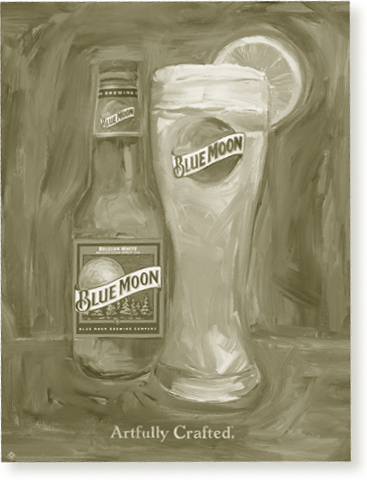
An advertisement for Blue Moon emphasizes its “craft” appeal—and its now-signature orange wheel garnish.
WITBIER CONSTITUTES a narrow band of flavors—at least among the finest examples. There are more out there, but these six will give you a good sense of the style.

LOCATION: Portland, ME
MALT: Pale, red wheat, unmalted white wheat
HOPS: Saaz, Styrian Golding
OTHER: Coriander, orange peel
5.0% ABV, 1.048 SP. GR., 21 IBU
In Allagash’s very pale example, you can see why people originally started calling these “white” beers. The aroma has a suggestion of coriander, pepper, and lemons that carries through to the palate, which is light and crisp. This is the driest of the witbiers, and the most suggestive of white wine. Allagash is complex and sere, a contrast to some crowd-pleasing versions out there.

LOCATION: Naka-shi, Japan
MALT: Pale, malted wheat, flaked wheat, flaked barley
HOPS: Perle, Styrian Golding
OTHER: Coriander, nutmeg, orange peel, orange juice
5.5% ABV, 1.055 SP. GR., 13 IBU
The nose of lemon meringue pie is surprising, given the various parts of Japanese oranges included in the beer, but it’s unmistakable. Hitachino Nest turns herbal on the palate, with a touch of hojicha tea and white pepper—and the requisite coriander. Heavier than most examples, and its grains taste of buckwheat.
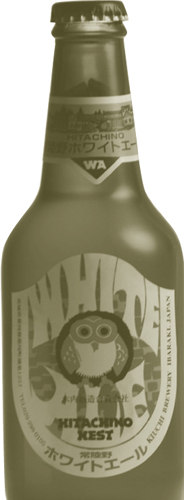

LOCATION: Watou, Belgium
MALT: Pilsner, wheat
HOPS: Target, Styrian Golding
5.5% ABV
Vivacious and heavily carbonated, St. Bernardus comes out of the bottle as opaque as a vanilla milkshake. It’s saturated in coriander but saved by a zingy tartness that’s suggestive of lemonade. Refreshing and uncomplicated.

LOCATION: Cooperstown, NY
MALT: Pilsner, wheat, unmalted wheat, oat flakes
HOPS: Spalter Select
OTHER: Coriander, orange peel
5.2% ABV, 1.046 SP. GR., 11 IBU
Witte follows the standard recipe, but the result is a more rustic beer, like a spiced saison. Tangy, light, and very refreshing, it has a strongly spiced layer, but doesn’t cloy. The spices and yeast conspire to create a wine-skin acidity that veers into zesty rather than sweet.
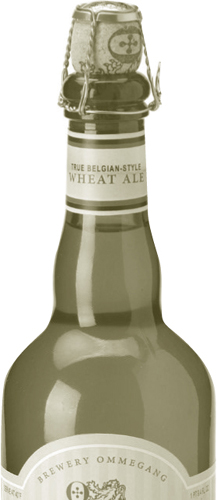

LOCATION: Falmignoul, Belgium
MALT: Pilsner, unmalted wheat
HOPS: Saaz, Styrian Golding
OTHER: Undisclosed spices
5.0% ABV
A lively, lovely rustic wheat ale, Troublette has a zesty, white-grape palate long on acidity and short on coriander. Light and refreshing, it compares with a pinot gris, but is sharper and more citrusy. The tartness and full wheat flavor hint at what the older Hoegaarden wits might have tasted like.

LOCATION: Dexter, MI
MALT: Pilsner, wheat malt, raw wheat
HOPS: Tettnang
OTHER: Coriander, sweet and bitter orange peel
4.9% ABV, 1.039 SP. GR., 15 IBU
If you want to take the Troublette thought experiment a step further, try Calabaza Blanca, a barrel-aged witbier that is even more acidic. In this beer, the tartness is a bright, lactic piquancy that has lots of lemon in it. “Yellow” springs to mind more than white when you’re drinking this beer, as the citrusy coriander and orange peels add more zing. The beer doesn’t bite, but it refreshes like the best fresh lemonade.